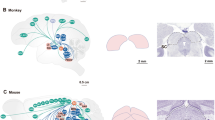Abstract
Throughout the normal vertebrate brain, visual maps from the left and right eyes overlap and are in register with one another. Visual input has a major role in the development of the pathways which mediate these binocular projections1–3. A dramatic example of the developmental role of sensory input occurs in the isthmo-tectal projection, which is part of the polysynaptic relay from the eye to the ipsilateral tectum of the frog, Xenopus laevis4–8. If one eye is rotated when the animal is still a tadpole, the isthmic axons respond by changing the topography of their terminations in the tectum; for example, a given isthmo-tectal axon which normally would connect with medial tectum can be induced to terminate in lateral tectum. Such rearrangements bring the ipsilateral visual map into register with the contralateral retinotectal map, even though one eye has been rotated. Indirect evidence8 has suggested that after early eye rotation, isthmo-tectal axons do not grow directly to their new tectal targets but instead reach those targets by routes which pass through their normal termination zones. Here I have used anterograde horseradish peroxidase labelling of isthmo-tectal fibres to show the trajectories of such axons and to compare them with the routes which axons take when allowed to develop normally. Tracings of individual axons in flat-mounted, unsectioned tecta show that most axons in normal Xenopus follow fairly straight paths in the tectum. In contrast, early eye rotation causes many isthmo-tectal axons to follow crooked, circuitous pathways before they terminate.
Similar content being viewed by others
References
LeVay, S., Wiesel, T. N. & Hubel, D. H. J. comp. Neurol. 191, 1–51 (1980).
Shatz, C. J. & LeVay, S. Science 204, 328–330 (1979).
Innocenti, G. M. & Frost, D. O. Nature 280, 231–233 (1979).
Gruberg, E. R. & Udin, S. B. J. comp. Neurol. 179, 487–500 (1978).
Grobstein, P., Comer, C., Hollyday, M. & Archer, S. M. Brain Res. 156, 117–123 (1978).
Glasser, S. & Ingle, D. Brain Res. 159, 214–218 (1978).
Keating, M. J. Br. med. Bull. 30, 145–151 (1974).
Udin, S. B. & Keating, M. J. J. comp. Neurol. 203, 575–594 (1981).
Nieuwkoop, P. D. & Faber, J. A Normal Table of Xenopus (Daudin) 2nd edn (North-Holland, Amsterdam, 1967).
Tay, D. & Straznicky, C. Neurosci. Lett. 16, 313–318 (1980).
Udin, S. B. Soc. Neurosci. Abstr. 7, 406 (1981).
Beazley, L., Keating, M. J. & Gaze, R. M. Vision Res. 12, 407–410 (1972).
Adams, J. C. J. Histochem. Cytochem. 29, 775 (1981).
Keating, M. J. & Feldman, J. Proc. R. Soc. B191, 467–474 (1975).
Runyon, R. P. & Haber, A. Fundamentals of Behavioral Statistics (Addison-Wesley, Reading, Massachusetts, 1967).
Horder, T. J. Brain Res. 72, 41–52 (1974).
Udin, S. B. Expl Neurol. 58, 455–470 (1978).
Meyer, R. L. J. comp. Neurol. 189, 273–289 (1980).
Fujisawa, H., Tani, N., Watanabe, K. & Ibata, Y. Devl Biol. 90, 43–57 (1982).
Frank, E., Harris, W. A. & Kennedy, B. M. J. Neurosci. Meth. 2, 183–189 (1980).
Author information
Authors and Affiliations
Rights and permissions
About this article
Cite this article
Udin, S. Abnormal visual input leads to development of abnormal axon trajectories in frogs. Nature 301, 336–338 (1983). https://doi.org/10.1038/301336a0
Received:
Accepted:
Issue Date:
DOI: https://doi.org/10.1038/301336a0
- Springer Nature Limited
This article is cited by
-
Visual input induces long-term potentiation of developing retinotectal synapses
Nature Neuroscience (2000)
-
Plasticity in the ipsilateral visuotectal projection persists after lesions of one nucleus isthmi inXenopus
Experimental Brain Research (1990)
-
Changing patterns of binocular visual connections in the intertectal system during development of the frog, Xenopus laevis
Experimental Brain Research (1989)
-
Normal maturation involves systematic changes in binocular visual connections in Xenopus laevis
Nature (1986)





